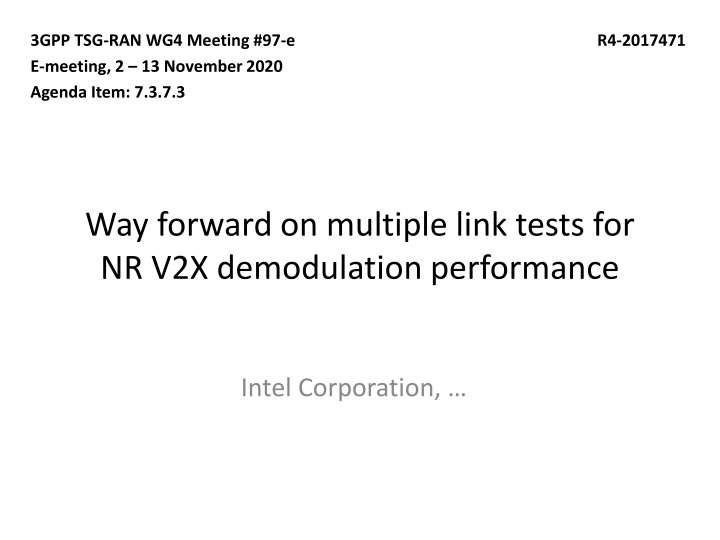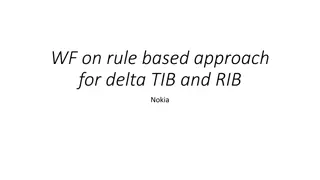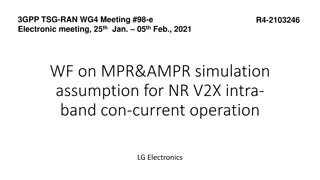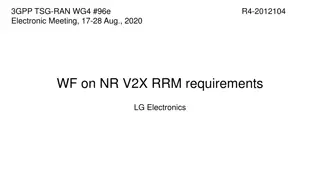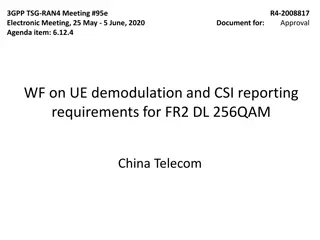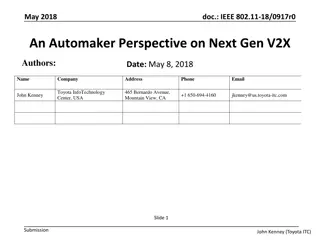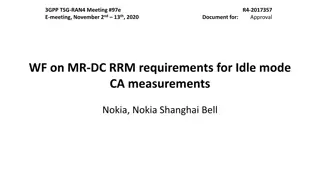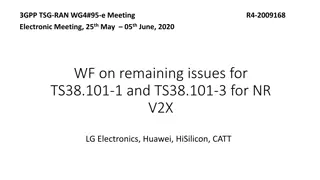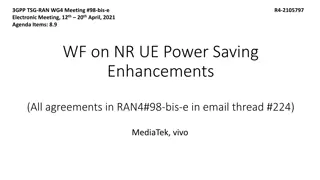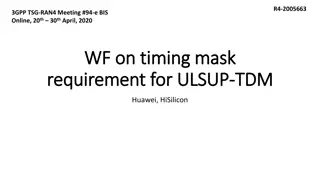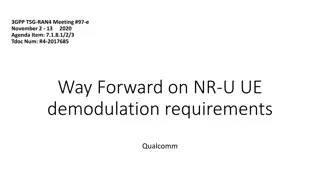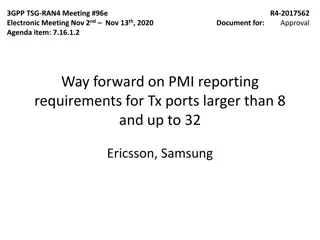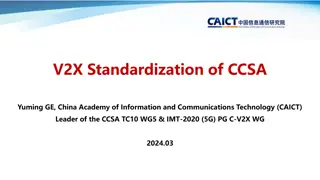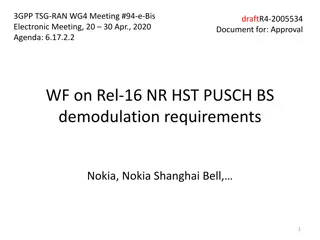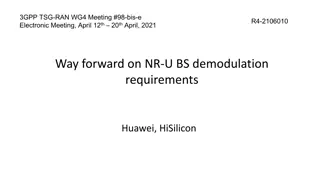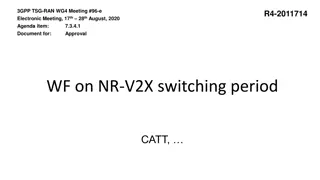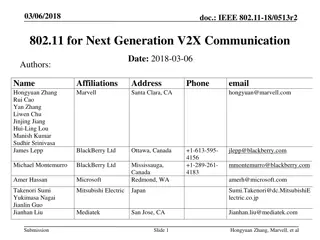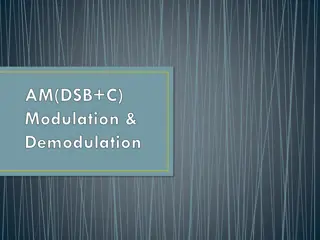NR V2X Demodulation Performance Analysis for RAN4 Meeting
Discussing power imbalance requirements, test methodologies, and configurations for NR V2X demodulation performance analysis. Includes HARQ buffer soft combining tests and MCS propagation conditions. The meeting also involves examining PSCCH/PSSCH decoding capabilities and deployment scenarios.
Download Presentation

Please find below an Image/Link to download the presentation.
The content on the website is provided AS IS for your information and personal use only. It may not be sold, licensed, or shared on other websites without obtaining consent from the author.If you encounter any issues during the download, it is possible that the publisher has removed the file from their server.
You are allowed to download the files provided on this website for personal or commercial use, subject to the condition that they are used lawfully. All files are the property of their respective owners.
The content on the website is provided AS IS for your information and personal use only. It may not be sold, licensed, or shared on other websites without obtaining consent from the author.
E N D
Presentation Transcript
3GPP TSG-RAN WG4 Meeting #97-e E-meeting, 2 13 November 2020 Agenda Item: 7.3.7.3 R4-2017471 Way forward on multiple link tests for NR V2X demodulation performance Intel Corporation,
Power imbalance requirements Methodology for NR V2X power imbalance test Reuse the methodology from LTE V2X power imbalance test ICS level Option 1: -27dBc ICS Option 2: ICS is higher than -27dBc Companies are encouraged to bring analysis on acceptable ICS level for NR V2X Distance between the two links Option 1: 10 PRBs Option 2: 30 PRBs Companies are encouraged to check the impact of IBE for options above for the next RAN4 meeting. PSSCH MCS 4 SCI format 2-A configuration Payload = 35 Bits, = 1, ??????? = 3.5. If no technical issues will be observed in the next RAN4 meeting, this configuration will be used for power imbalance requirements. Test metric: PSSCH BLER 10% of Sidelink UE 2 2
HARQ buffer soft combining test Test purpose The main test purpose is to verify HARQ buffer combining. Configuring of high MCS and long interval between transmission and retransmission is not precluded. Test design CBW: 20 MHz Sub-channel size: 10 or 15 For verification of n16 and n24, 16 or 24 UEs transmit signal one by one circularly for every slot and in the first subchannel. For verification of n32, the first 31 UEs transmit signal one by one circularly for every slot and in the first subchannel. The 32nd UE transmit signal in the same slot as the first UE but in the second subchannel. For verification of n64, first 31 UEs transmit signal one by one circularly for every slot and in the first subchannel, the next 31 UEs transmit signal one by one circularly for every slot and in the second subchannel, the last 2 UEs transmit signal in the same slot as the first two UEs but in the third subchannel. 3
HARQ buffer soft combining test MCS Propagation conditions AWGN channel model PSCCH resource allocation: 2 symbols and 10 RBs 2 DMRS symbols for PSSCH PSFCH configuration Option 1: No PSFCH Option 2: PSFCH with periodicity 4 Option 3: PSFCH with periodicity 1 SCI stage 2 configuration Payload = 35 Bits, ??????? = 2.5 If no technical issues will be observed in the next RAN4 meeting, this configuration will be used for HARQ buffer soft combining requirements. Test metric 5% of PSSCH BLER Other issue Further discuss how to take into account psfch-TxNumber capability if needed Option 1: MCS 13 Option 2: MCS 28 (64 QAM, 948/1024) for MCS index Table 1 4
PSCCH/PSSCH decoding capability test CBW/SCS Need to further check on the supporting CHBW sets on V2X band, mandatory or optional and typical deployment scenarios, RAN4 planed to make decision among 40MHz and 20MHz in RAN4#98e. PSFCH configuration Option 1: No PSFCH Option 2: PSFCH with periodicity 1 DMRS configuration: 2 DMRS symbols MCS 4 Propagation conditions: Static propagation condition without external noise Test metric: Probability of missed PSCCH 1% Other issues Further discuss how to take into account psfch-TxNumber capability if needed Further discuss whether to verify 2*floor(NRB /10 RBs) capability 5
PSFCH decoding capability test Test design N UEs transmit PSFCH one by one following procedure from Section 16.3 of TS 38.1213 N is {5, 15, 25, 32, 35, 45, 50, 64} depending on UE capability Just for information. Example for 20 MHz, 1 sub-channel and PSFCH periodicity 1 When N is not larger than 51, all N UEs should transmit one by one from RB 0 to A-1 with CS pair index 0. When N=64, UE i, 0 i 50 should transmit PSFCH one by one from RB 0 to 50 with CS pair index 0, the remaining 13 UEs (i.e. UEi, 51 i 63) should transmit PSFCHs from RB 0 to RB 12 with CS pair index 3. CBW/SCS Option 1: 20 MHz, 30 kHz Option 2: 40 MHz, 30 kHz Number of sub-channels Option 1: 1 Option 2: Maximum possible for considered scenario (i.e. 5 for 20 MHz and 10 for 40 MHz) PSFCH periodicity Option 1: 1 Option 2: 4 6
PSFCH decoding capability test Feedback mode: ACK/NACK Propagation conditions Static propagation condition without external noise Test metric Pr(DTX to ACK)<1% and Pr(ACK miss)<1% Further discus introduction of additional test metric as Pr(NACK to ACK) 7
SDR with active sidelink test Whether to define the SDR test with active sidelink? Option 1: Yes Option 2: No 8
